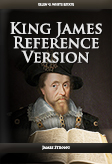Versions

American King James Version
This is a new edition of the Holy Bible, based on the original King James Version. It is a simple word for word update from the King James English. Care has been taken to not make any doctrinal changes, but to simply update the spelling and vocabulary. No grammatical changes have been made in order to retain meaning.

American Standard Version
The American Standard Version of 1901 is based on the Revised Version Bible, a collaborated revision by dozens of British and America scholars in the 1880s. The text is an update of the KJV, with more modern spelling and greater accuracy of translation. It has been called “The rock of Biblical honesty, ” although it never surpassed the KJV in popularity of use. A notable change from the KJV is reference to God as “Jehovah ” instead of the traditional “Lord.”

Darby Bible
This Bible was first published in 1890. The New Testament translation was published in 1867 by John Nelson Darby, an Anglo-Irish Bible teacher associated with the early years of the Plymouth Brethren. The later Old Testament publication was based on his translations into French and German, and was completed in English by his students, after his death. The Darby Bible’s official title reads, “A new translation from the original languages,” and its text reflects that with modernized language and spelling. Darby also published translations of the Bible in French and German.

King James Version
The third official English translation of the Bible, the King James Version was first published in 1611 and has remained the standard for many theologians and Bible scholars to this day. It has also been the basis for many other English Bibles, forming the foundation of their text. Commissioned under King James of England, the seven-year-long translation was performed from Hebrew (Old Testament) and Greek (New Testament) by 47 scholars, based at Westminster, and the Universities at Cambridge and Oxford.

King James Reference Version
Authorized King James Version with Strong's Markup

King James Bible With Strong’s Dictionary
A Bible dictionary of every word contained in the King James Version

Webster’s Bible
This lightly-revised version update of the King James Version was originally published in 1833 by Noah Webster. While Webster wanted to update certain aspects of the language, his aim was not to make it entirely modern. Therefore, his translation is very similar—almost identical—to that of the original King James Version.

World English Bible
The World English Bible (WEB) is a modern English translation of the Bible which is available in the Public Domain. Though still in draft form, the text is free for copying and use by the public. Based on the American Standard Version (ASV), this translation uses modern language and spelling. Some notable changes from the KJV are reference to God as “Yahweh” and lowercase “he,” instead of the traditional “Lord” and “He.”

Young’s Literal Translation
Young's Literal Translation of the Bible is fundamentally different from other, more common translations in that the YLT aims for strict adherence to the literal meaning of the original Hebrew or Greek text. Therefore, for example, many passages are written in present tense where traditional versions would be past tense. Originally published in 1862, the most recent revision was made in 1898, after Young's death.









